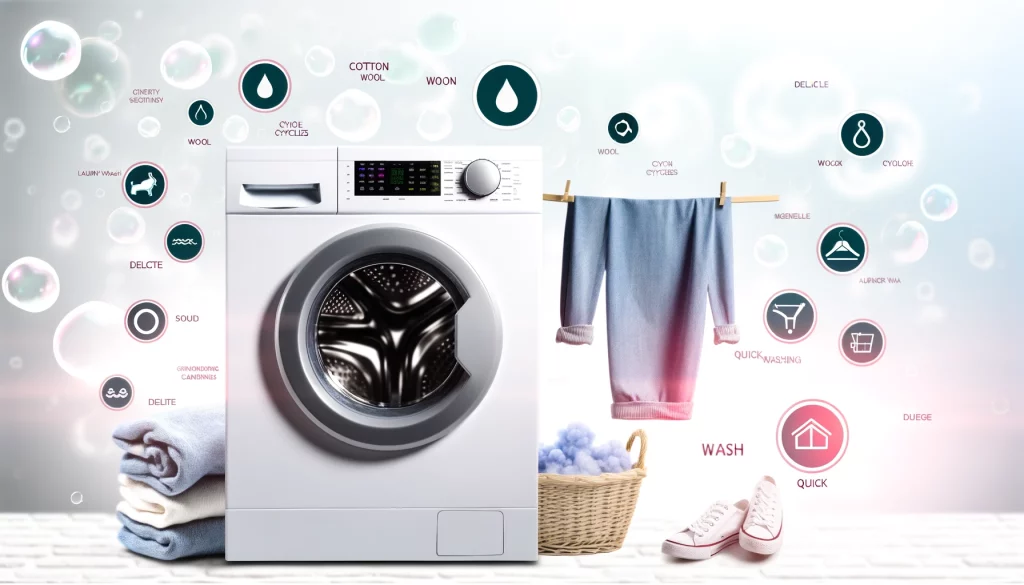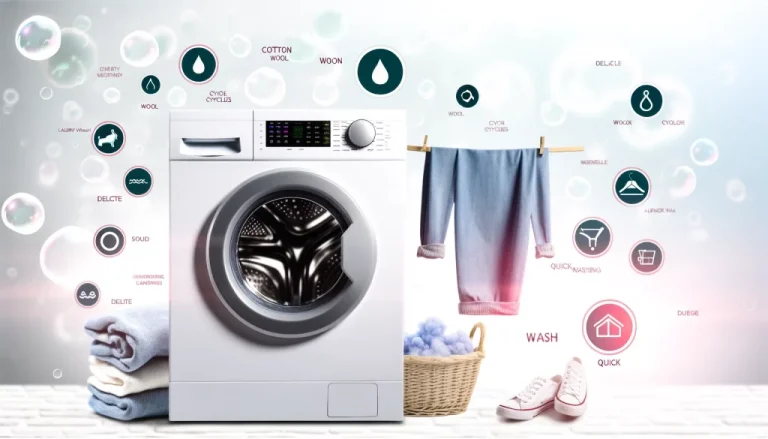Navigating the plethora of washing machine cycles can feel overwhelming, but mastering these settings can transform your laundry routine. Whether you’re dealing with delicate fabrics or heavily soiled work clothes, understanding each cycle’s purpose is key to achieving optimal results. For more tips and tricks on everyday tasks, check out the offerings at InktasticMerch.
Confused by your washing machine’s myriad settings and cycles? You’re not alone. Many people are unsure which cycle to pick, risking potential damage to their clothes. Modern washing machines boast a variety of cycles tailored for different types of clothing and fabrics, ensuring optimal cleaning while safeguarding your garments.
Our guide simplifies these options, helping you select the best settings for any load. By familiarizing yourself with these choices, you can enjoy cleaner clothes with minimal effort.
Key Takeaways
- Machines offer cycles like normal, quick wash, heavy duty, and delicate to suit various fabric types and soil levels.
- Special cycles such as bulky or bedding are ideal for large items, ensuring thorough cleaning without harm.
- Adjust water temperature based on fabric care instructions—cold for delicates, warm for general use.
- Soil level settings let you adjust the machine’s intensity to match the dirt on your clothes.
- Extra options like steam cleaning can help remove stubborn stains, reduce wrinkles, and eliminate allergens.
The 7 Main Washing Machine Cycles Explained

Washing machines are equipped with diverse cycles to meet your laundry needs. Discover the seven main cycles, ranging from normal to delicate, and understand how they simplify the process of cleaning clothes.
| Cycle Name | Description | Typical Use Case | Duration |
|---|---|---|---|
| Normal | High-speed wash and spin for everyday laundry. | Standard clothing like shirts, pants, and undergarments. | 8 to 15 minutes |
| Speed or Quick Wash | Shortened wash with high-speed spin for lightly soiled clothes. | Lightly soiled clothes needing a fast clean. | 15 to 40 minutes |
| Heavy Duty | High-speed wash and spin for heavily soiled or odorous items. | Work clothes and other items with heavy stains. | Longer than Normal |
| Bulky | Adjusts water levels and agitation for large items. | Large or delicate items like blankets and pillows. | Variable |
| Bedding and Sheets | Longer washing and rinsing times for large fabric pieces. | Bed linens and sheets. | Longer than Normal |
| Delicate or Hand Wash | Slow agitation and minimal spin to mimic hand washing. | Fragile fabrics like lingerie, silk, and lace. | Variable, slower than Normal |
| Rinse and Spin | Additional rinsing and reduced spin speed to remove detergent residue. | Any garments with leftover soap, especially dark and colored fabrics to prevent detergent residue. | Shorter, varies |
Normal
The normal cycle is perfect for your daily laundry tasks. It employs a high-speed wash and spin to effectively clean everyday clothes. Ideal for standard apparel like shirts, pants, and undergarments, this cycle doesn’t require any special treatment.
With a duration of 8 to 15 minutes, it’s crafted for average laundry loads and stands as the most frequently used setting.
Choosing the normal cycle ensures your daily laundry is efficiently cleaned without needing additional adjustments. It balances water usage and spin speed to cater to regular clothing with ease.
For typical washing machine cycles concerning
With its regular spin speed and settings tailored for standard garments, this option offers a dependable solution to maintain your everyday apparel’s freshness and cleanliness.
Speed or Quick Wash
Ideal for lightly soiled clothes that need a swift clean, the Speed or Quick Wash cycle delivers efficiency. This setting merges a brief wash cycle with a high-speed spin, greatly reducing drying time.
Running for about 15 to 40 minutes, it suits hectic schedules or moments when you’re pressed for time. Integrating both rapid wash and express wash techniques, it provides cleanliness faster than regular cycles.
Let’s now delve into the Heavy Duty cycle, crafted for deeply soiled items and durable fabrics.
Heavy Duty
Effortlessly managing heavily soiled or odorous garments, the heavy duty cycle is your go-to option. It features a high-speed wash paired with an extensive spin, outlasting a standard cycle. This intensive setting is perfect for workwear that may be heavily stained, delivering a thorough wash.
Utilizing hot water and a brisk spin speed, it penetrates deep into dense, sturdy fabrics needing extra care and powerfully washes away persistent stains with industrial-strength cycles.
Now, let’s explore what the Bulky washing machine cycle offers.
Bulky
Certain washing machines feature a bulky cycle, specifically for large items like blankets and pillows. It’s also suited for ultra-delicate garments that require gentle handling during cleaning.
This cycle optimizes water levels and agitation to protectively clean large, delicate items. Opting for the bulky cycle gives ample care to your oversized laundry. By using more water and a unique spinning motion, it ensures thorough cleanliness for comforters, heavy winter jackets, and other sizable wash challenges.
Bedding and Sheets
After the bulky cycle discussion, let’s shift to bedding and sheets. This cycle expertly manages large fabric items like linens, thoroughly cleansing them without risk. It utilizes extended washing and rinsing times for optimal cleanliness.
Electing this cycle for your bedding provides a thorough clean, helping them last longer.
Knowing how to effectively use the bedding and sheets cycle protects your linens from damage, handling these textiles gently while ensuring a deep clean, thereby prolonging freshness.
This understanding is vital for linen preservation and textile care.
Delicate or Hand Wash
The delicate or hand wash cycle offers gentle care for sensitive materials, simulating hand washing with its soft agitation and minimal spinning to protect fragile fabrics like lingerie, silk, and lace.
This setting employs a “slow/slow” approach to safeguard delicate garments, ensuring reduced agitation speeds and a gentle spin cycle. It’s perfect for items needing extra attention, preventing stretching and snagging.
Following the gentle touch of the delicate or hand wash cycle, we now investigate the rinse and spin settings.
Rinse and Spin
The rinse and spin cycle effectively eliminates detergent residue left from the initial wash. Providing additional rinsing alongside a reduced spin speed, it’s ideal for caring for dark and colored fabrics.
This cycle ensures garments emerge clean without detergent residue, protecting colors from fading. With gentler wash and spin actions, it helps maintain garment vibrancy for longer.
Use that feature to ensure all detergent is rinsed out completely, maintaining your fabric’s quality.
Decoding Washer Settings

Grasping the intricacies of washer settings allows you to tailor your laundry’s treatment to ensure the best results.
Water Temperature
Water temperature is fundamental in laundering. Cold water, ranging from 60 to 85 degrees Fahrenheit, is ideal for delicate materials and is energy-efficient. Warm water cycles offer flexibility, handling various fabrics without risking shrinkage or color loss.
The Permanent Press cycle provides gentle agitation at approximately 85-105 degrees, safeguarding colors and minimizing wrinkles.
Choosing the proper water temperature is guided by your fabric’s care instructions and clothing types. Cold washes are advantageous for tender materials and contribute to lowering energy bills.
Conversely, warm water effectively cleans moderately soiled garments, ensuring thorough washing without compromising fabric integrity. Always refer to garment labels for temperature recommendations to achieve optimal results.
Soil Level
After deciding on water temperature, selecting the right soil level for your load is vital. This setting tunes the machine’s intensity based on your clothes’ dirtiness.
Low soil levels are suitable for lightly soiled items, conserving energy and protecting fibers by reducing wash time and agitation. Conversely, high soil levels cater to heavily stained pieces, enhancing agitation and extending washing time for a deep clean.
Aligning the soil level with your garments’ condition ensures effective cleaning while conserving water and energy.
The washer adapts water usage automatically when you adjust the soil level. Tough stains require more water and longer agitation, while fresher items benefit from minimal water use for quick cleaning.
This feature not only customizes each wash but also enhances environmental sustainability by optimizing resources. Always inspect garment labels and consider stain types when setting soil levels to avoid damage and maintain optimal cleanliness.
Water Level and Auto-Sensing
Adjusting from soil to water level highlights the necessity of setting adjustments for optimal cleaning. Some washers boast auto-sensing capabilities, gauging load size to adjust water accordingly.
This process guarantees adequate water use, minimizing waste and maximizing cleaning efficiency. Auto-sensing controls water based on load size, making manual settings optional.
Proper water level selection aids in resource-saving while ensuring effective cleaning. Machines with smart sensing provide a distinct edge by automatically calibrating the necessary water for each cycle.
This capability guarantees efficient water use for both large and small loads, ensuring thorough washing without excess consumption.
Steam Clean
The steam clean function leverages steam to effectively remove dirt and stains. This setting goes beyond traditional cleaning by reducing wrinkles, preventing shrinkage, and eliminating odors.
Steam thoroughly disinfects fabrics, eradicating allergens and germs, making it a superb option for deep cleaning without using harsh chemicals.
LG emphasizes the transformative role of steam in achieving pristine cleanliness and freshness.
The steam cycle plays an essential role in maintaining your washing machine. It helps keep the tub pristine by reducing residue, mold, mildew, and unpleasant odors that often accumulate over time. This ensures your machine remains fresh and primed for every load, with no extra effort required from you.
Extra options
Enhance your laundry experience with additional features in your washing machine. The Extra Rinse setting is perfect for eliminating detergent remnants, especially from absorbent materials like towels. This feature is particularly beneficial for those with sensitive skin or anyone keen on achieving exceptionally clean laundry.
Exploring various laundry care options empowers you to customize each wash cycle to meet your fabrics’ specific demands. These settings help preserve fabric quality and extend your clothes’ lifespan by delivering the precise care they need during washing.
Tips for Properly Using Washer Settings
Master your laundry by choosing the right washer settings according to fabric type, water temperature, and soil level, ensuring your clothes remain in excellent condition. Read on to become adept at doing laundry.
Using the appropriate cycle for different fabric types
Selecting the proper wash cycle is vital for fabric preservation. Various fabrics demand distinct cycles to maintain their quality and durability. Use a delicate or hand wash cycle for fragile fabrics like silk or lace. This gentle setting avoids damage, ensuring these materials look fantastic. Opt for a normal or heavy-duty cycle for robust fabrics like cotton or denim, as they clean thoroughly without harming durable materials.
For washing bulky items such as towels or bedding, choose the bulky or bedding and sheets cycle. This option provides additional water and movement to guarantee even cleaning of large items. Always consult clothing labels for care instructions before choosing your washer settings. Properly using washer settings enhances your clothes’ longevity by balancing cleanliness and fabric maintenance.
Choosing the right water temperature and soil level
After picking the best cycle for your fabrics, selecting the appropriate water temperature and soil level is crucial. Warm water temperatures (between 105°F and 120°F) suit most cycles like normal and quick wash. Hot water removes tough stains from heavily soiled clothes, but use it sparingly to prevent damage. Cold water is ideal for delicate fabrics and colors that may bleed. Adjusting the soil level lets the machine optimize agitation and cleaning time.
Different loads require specific settings to ensure thorough cleaning without damaging fabric. Lightly soiled items can be washed with less water and a shorter cycle, saving energy. Heavily soiled clothes might need more water and extended wash times. Using the correct settings not only cleans your clothes effectively but also prolongs their lifespan by avoiding wear from excessive heat or agitation.
Utilizing extra options such as steam clean
The steam clean feature in washing machines provides a powerful method for tackling stubborn stains and dirt. By using hot steam, it penetrates deep into fabric fibers, removing dirt more effectively than water alone. This is ideal for heavily soiled items or individuals with allergies, as it helps eliminate allergens.
Opting for the steam clean setting makes clothes not only look cleaner but feel fresher too. Manufacturers claim this option enhances cleaning, achieving a sanitary level hard to replicate with traditional settings. It even reduces clothing wrinkles, simplifying your laundry routine by reducing the need for ironing.
Conclusion
Choosing the right washing machine cycle is essential for optimal care and maintenance of your textiles.
Choosing the right settings for your laundry significantly influences fabric care and longevity. Understanding these options ensures that clothes are thoroughly cleaned without being harmed.
Deciding between a quick wash and a heavy-duty cycle can efficiently save both time and energy. Selecting the appropriate water temperature and features like steam clean optimizes the washing process. By mastering these settings, you can transform a chore into a straightforward task, making laundry day less of a guessing game.
FAQs
1. What does the “regular” cycle on a washing machine do?
The “regular” cycle effectively cleans everyday garments with a standard level of dirt.
2. When should I use the “delicate” cycle?
The “delicate” cycle is ideal for items made from fragile materials or requiring gentle handling.
3. Can I wash all my clothes on the “quick wash” setting?
The “quick wash” setting is suitable for lightly soiled items that need a rapid clean, not for all laundry types.
4. What’s the difference between hot and cold water settings?
Hot water is more effective for removing heavy soils, whereas cold water is better for delicate fabrics and conserving energy.
5. Why would I choose the “heavy duty” cycle?
Select the “heavy duty” cycle for heavily soiled or large, bulky items that require robust cleaning power.
To explore more insightful tips and guides on various topics, visit our Blog and enhance your daily routines with expert advice.




